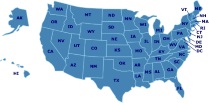Libraries
Research Libraries in Wyoming
Crook County Museum & Art Gallery
National Libraries
America's Story from America's Library
Library of Congress
American Memory
Libraries & Homeschoolers: Working Together
Homeschoolers and the Public Library
Public libraries are invaluable tools for DIY educators and home education. Home-based educators utilize various curriculum sources to assist in teaching. The National Center for Educational Statistics published a survey from 2012, in which 70% of homeschooled parents cite the public library as their most valued resource. This article, written for the American Library Association, details how librarians can meet the needs and work in partnership with homeschooling families.
How to Homeschool Using Only the Library
The library is a wonderful resource for any homeschool parent. The resources found there help to enrich the curriculum or you can even use the library for all of your homeschooling material. These tips will help you get the most out of your local library.
19 Ways to Get the Most from Your Library
We all know the library is the homeschooler’s best friend. Where else can you go to find all those wonderful books, DVDs, and more for free? But your librarian can be even more helpful than you had realized. Here are some tips for getting the most from your library.
Public Libraries Welcome Growing Homeschool Community
Public libraries around the country are finding new ways to serve the growing population of homeschoolers through physical spaces and creative programs catered to homeschooling families’ needs. This article takes a look at what libraries in Illinois, Colorado, and Tennessee are doing to meet the diverse needs of homeschooling families.
Homeschooling: Exploring the Potential of Public Library Service for Homeschooled Students
As the number of homeschooled students rises in this country, needs for resources, instruction and support also has risen. The homeschooled students, while not participating in the school classrooms and by extension the school or public libraries, have needs that should be satisfied by library services. These include access to materials and technology, information literacy skills instruction, reading and writing support, curriculum materials and methods, reference services, as well as areas to “make and take”, facilities for quiet study or to meet with mentors or tutors. In addition, homeschooled students need the kind of library skills instruction that all students in traditional school libraries receive. The purpose of this study is to identify the strengths and weaknesses of library support to homeschooled students and to make recommendations based upon analysis.
Helping Homeschoolers in the Library
This practical guidebook seeks to bridge the gap between librarians and homeschoolers in these two ways: who are homeschoolers and how can I help them practically? Part 1 addresses the history and background of homeschooling as well as the needs and viewpoints of various homeschooling groups. Part 2 deals specifically with building programs and services for the homeschooling population. By moving past stereotypes and understanding what resources are available, librarians can be important allies to this diverse group of patrons. Children's and YA librarians, library directors, support staff working with youth in public libraries and educators will find the information and tools they need to develop policies, programs, and services to support homeschoolers in their communities.
Homeschooling and Libraries
Homeschooling and Libraries: New Solutions and Opportunities
Homeschools are alwsy looking for alternative ways of schooling that do not necessarily reflect what a typical classroom looks like. Since homeschooling is so diverse across families, information institutions, including public, academic, school, and special libraries may find it challenging to meet all their needs and desires. This collection of essays offers approaches and strategies from library professionals and veteran homeschoolers on how to best serve the needs and experiences of homeschooled youth. This book includes information on special needs homeschooling, gifted students, and African American students as well.
Homeschool Library Connection
A Home Away from Home: Libraries & Homeschoolers
Homeschoolers’ Experiences with the Public Library
The purpose of this study was to understand the experiences of homeschoolers using the public library. A phenomenological design using interviews, a survey, and a writing prompt was used to give voice to the public library experiences of seven homeschool participants. From the data, three primary themes surfaced. First, most of the participants felt that the library was a home away from home. Next, many of the participants valued how the public library saved them money, and finally, many of the participants voiced a desire for more library daytime programs, especially daytime programs that catered to older, homeschooled children.
Featured Resources
As an Amazon Associate, we earn from qualifying purchases. We get commissions for purchases made through links on this site.





